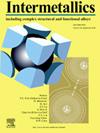Impact of thermal vibrations on the stability of the FeSn2 intermetallics
IF 4.3
2区 材料科学
Q2 CHEMISTRY, PHYSICAL
引用次数: 0
Abstract
We have performed a combined theoretical and experimental study of FeSn intermetallics. We were motivated by a scarcity of published data as well as previous theoretical calculations of the antiferromagnetic (AFM) state of FeSn, when this compound was found mechanically unstable due to imaginary-frequency phonons. Addressing both mechanical and thermodynamic stability within density-functional-theory (DFT) calculations, we focused on the AFM state as well as the ferromagnetic (FM) state of FeSn, which were both considered in earlier experiments. In contrast to the previous calculations, we found the AFM FeSn state mechanically stable (no imaginary-frequency phonons). The same is true for the FM state, which possesses a slightly higher energy than the AFM state. The mechanical stability allowed for assessing the thermodynamic properties within both harmonic approximations as well as computationally much more demanding quasi-harmonic approximation. Interestingly, while the static-lattice formation energy of AFM FeSn is negative and, therefore, the compound is predicted stable with respect to the decomposition into elemental end-members, phonon-related contributions have a destabilizing impact at low temperatures. Our calculations were complemented by the experimental characterization of Fe-Sn samples, and the experimental FeSn lattice parameters were found neatly matching the theoretical values.

求助全文
约1分钟内获得全文
求助全文
来源期刊

Intermetallics
工程技术-材料科学:综合
CiteScore
7.80
自引率
9.10%
发文量
291
审稿时长
37 days
期刊介绍:
This journal is a platform for publishing innovative research and overviews for advancing our understanding of the structure, property, and functionality of complex metallic alloys, including intermetallics, metallic glasses, and high entropy alloys.
The journal reports the science and engineering of metallic materials in the following aspects:
Theories and experiments which address the relationship between property and structure in all length scales.
Physical modeling and numerical simulations which provide a comprehensive understanding of experimental observations.
Stimulated methodologies to characterize the structure and chemistry of materials that correlate the properties.
Technological applications resulting from the understanding of property-structure relationship in materials.
Novel and cutting-edge results warranting rapid communication.
The journal also publishes special issues on selected topics and overviews by invitation only.
 求助内容:
求助内容: 应助结果提醒方式:
应助结果提醒方式:


